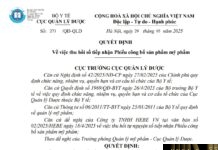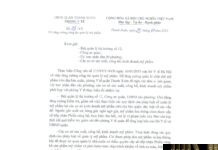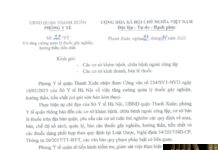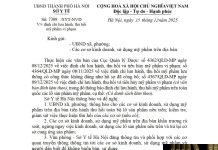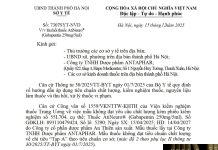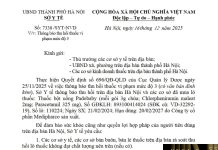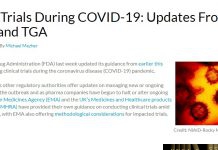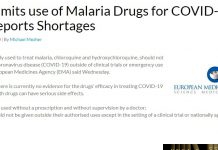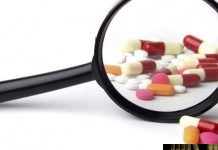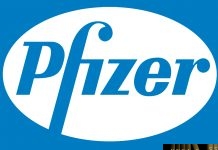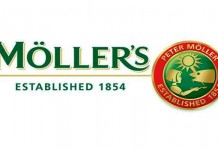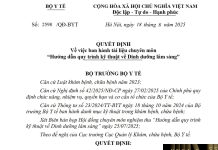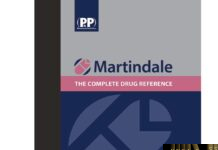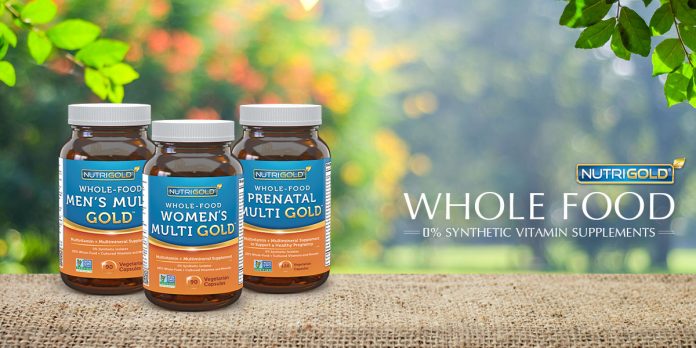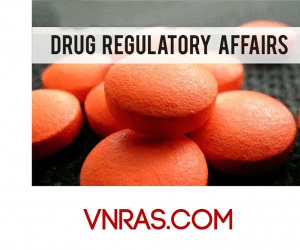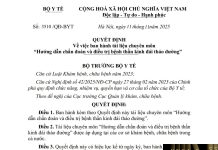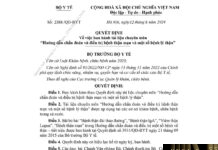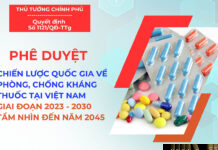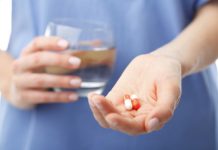The Decision 16/QĐ-K2ĐT Issue the technical documentation “Guideline for Non-Clinical & Clinical studies on similar biological medical products in Viet Nam”
| MINISTRY OF HEALTH
Administration of science technology and Training |
SOCIALIST REPUBLIC OF VIETNAM
Independence – Freedom – Happiness |
| No. 16/QĐ-K2ĐT | Hanoi, March 30th 2016 |
Decision
Issue the technical documentation “Guideline for Non-Clinical & Clinical studies on similar biological medical products in Viet Nam”
Director of Administration of science technogoly and Training
Pursuant to Decree No. 63/2012/ND-CP dated 31/08/2012 of the Government on the functions, tasks, powers and organizational structure of the Ministry of Health;
Pursuant to Decision No 4059/QĐ-BYT dated 22/10/2012 of Minister of Ministry of Health on the functions, tasks, powers and organizational structure of the Administration of science technology and Training, Ministry of Health.
Pursuant to Decision No 3220/QĐ-BYT dated 31/07/2015 on founding Evaluation Council to guide on non-clinical and clinical studies in similar biological medical products (biosimilars) development in Viet Nam.
Pursuant to Minute of meeting dated 13/08/2015 and the minute of vote checking of evaluation Council to guide non-clinical and clinical studies in biosimilars development in Viet Nam.
At the request of the Head of Clinical trial and product research Administration
DECISION
Article 1. To issue together with this Decision the technical documentation “Guidelines for Non-Clinical & Clinical studies on similar biological medical products in Viet Nam “.
Article 2. The research and development facility when there is demand for “non-clinical and clinical trial studies on similar biological medical products in Viet Nam” conduct research according to this guidance in order to implement studies ensuring the scientific and morality.
Article 3: This Decision is valid from signed and issued date.
Article 4: Officers of relevant departments are responsible for the implementation of this decision.
Receipt:
- As Article 4 Director
- Vice Minister: Le Quang Cuong
- Vice directors
- Website of ASTT, IEC
- Archive: Ad Dept, TNLS
MINISTRY OF HEALTH
THE GUIDELINE FOR PRE-CLINICAL AND CLINICAL STUDIES IN BIOSIMILARS DEVELOPMENT IN VIET NAM
HA NOI 2015
CONTRIBUTORS
- Ass Prof. PhD Trinh Van Quy
- Ass Prof. PhD Ha Phan Hai An
- PhD Nguyen Ngo Quang
- PhD Nguyen Thi Lien Huong
EDITORIAL BOARD
- Do Duc Van
- A/Prof. Le Van Dong
CONTENT
| Items | Trang |
| PREFACE | |
| ABBREVIATION LIST | |
| TERMINOLOGY EXPLANATION | |
| CHAPTER 1: PRINCIPLES IN BIOSIMILAR RESEARCH | |
| 1.1. Introduction of SBP & RBP | |
| 1.1.1. General concept | |
| 1.1.2. SBP | |
| 1.1.3. RBP | |
| 1.2. Scienfitic aspects of great interest in SBP research | |
| 1.3. Quality of SBP | |
| 1.3.1. Manufacturing process criteria | |
| 1.3.2. Product’s profile | |
| 1.3.3. Quality Criteria | |
| 1.3.4. Analytic techniques | |
| 1.3.5. Product stability | |
| Chapter 2: PRE-CLINICAL STUDIES OF SBP | |
| 2.1. General guidance | |
| 2.2. Specific guidance | |
| Chapter 3: CLINICAL STUDIES OF SBP | |
| 3.1. Pharmacokinetics studies | |
| 3.2. Pharmacodynamics studies | |
| 3.3. Efficacy comparison studies | |
| 3.4. Safety studies | |
| 3.5. Immunogeneicity studies | |
| 3.6. Efficacy & Safety profile extra-polation to other indications | |
| 3.7. AE report in SBP research | |
| 3.8. Ethical issues in SBP research | |
| Chapter 4: ROLE AND RESPONSIBILITY OF AUTHORIRIES IN SBP RESEARCH MANAGEMENT | |
| 4.1. SBP study management | |
| 4.2. Registration Doc Assessment Guidance | |
| 4.3. AE management pre- and post-approval phases of SBP | |
| APPENDIX | |
| REFERENCE |
Preface
Biopharmaceuticals are protein synthesized by modern bio-technologies or advanced know-hows.
The substances have been translated into therapeutic products and licensing circulation on the market since the beginning of the 80s of XX century, establishing an important new milestone in drug treatment, significantly improve quality the lives of millions of patients suffering from serious diseases or life-threatening chronic diseases. Currently, the next generation of biological drugs first inventor was born and applied in medicine, these products are called biological drugs “similar”.
Unlike pharmaceutical drugs, biological drugs in size and molecular weight much larger, very complex composition, are created in an environment with many living cells with fluctuating factors. Manufacturing processes and multiple steps usually so characteristic of the final product are more affected by these factors. The stable quality of the production batch to batch production is a big challenge. In some cases, a small change in production, even in the storage and transportation of products may alter the safety and effectiveness of products. Maybe so, when it comes to probiotics, people often refer to the paradoxical phrases (Dogma) as “the process of product does it.”
On the basis of current analytical techniques, although very advanced and modern, it has not been able to prove 2 product of a biological substance from two different production processes are identical , which is the highest just might be “similar” together. Thus, the term is suitable for this type of product is bio-similar drugs (biosimilar), and to avoid misunderstandings, people do not use the term biological drugs version (biogeneric).
Count immunogenicity of biological drugs are aspects of clinical care much. Therefore, clinical trials, along with the maintenance of pharmacovigilance after drugs are circulating in the market is essential to ensure the safety and efficacy of the product.
Similar biological drugs is an issue of interest from a range of stakeholders, from the physician to the patient, from the research and production of drugs to the health authorities. However, the supply of similar biological medicines to patients is often associated with the technical challenges as well as legislation, while the experience of this type of product was still limited.
It is clear that patients with legitimate requests for providing a spacious day biological drugs at cheaper prices. In Vietnam, some companies manufacture and sale of pharmaceuticals were also interested in the research, development, testing and licensing a similar biological medicines to meet that requirement. However, there are differences in approach to managing the regulation on these products between the countries in the world, it has set out the need to define the principles and requirements in terms of regulation for these products on a global scale. World Health Organization (WHO) issued a general guideline for the assessment of similar biological medicines.
To ensure that similar biological medicines in Vietnam is a healthy development for patients to access medicines quality, safety and efficiency with reasonable prices, the Guide provides concepts and is basics, the principled point in developing similar biological medicines; professional guidance in non-clinical studies and clinical trials; and management requirements are in place for similar biological medicines. The contents of the Guide were selected references from the respective guidelines of the WHO and some countries in the region and the world, with reference to the conditions and regulations of Vietnam in order to ensure the availability and harmonized implementation of the integration process. With specialized content in this Guide, the research unit produced similar biological medicines will determine the framework for research and development and product testing in order to be recognized a similar biological medicines biological reference medicines in terms of safety and efficacy. Physicians and patients also found in this Guideline basic understanding of biological drugs for satisfactory selection of medication during treatment. On the basis of the Guidelines, the management bodies and the regulation of pharmaceutical research will build on the profile specified in the authorization process; expert assessment records may apply when considering licensing records similar biological medicines in Vietnam.
ABBREVIATION LIST
| No | Abbreviation | Full name |
| 1 | Biosimilar | Thuốc sinh học tương tự |
| 2 | SBP | Sản phẩm trị liệu sinh học tương tự (Similar biotherapeutic products) |
| 3 | RBP | Thuốc sinh học đối chứng (Refference biotherapeutic products) |
| 4 | WHO | Tổ chức Y tế Thế giới |
| 5 | PK/PD | Nghiên cứu dược lực học/dược động học |
TERMINOLOGY EXPLANATION
Similar biotherapeutic product (SBP)
A biotherapeutic product which is similar in terms of quality, safety and efficacy to an already licensed reference biotherapeutic product.
Biosimilars or similar biotherapeutic products – (SBP) is used in EU and several other Asian countries, other names have been used by some countries such as “follow-on protein products” (USA, Japan) or “subsequent-entrybiologics” (Canada).
Reference biotherapeutic product (RBP)
A reference biotherapeutic product is used as the comparator for head-to-head comparability studies with the similar biotherapeutic product in order to show similarity in terms of quality, safety and efficacy. Only an originator product that was licensed on the basis of a full registration dossier can serve as a RBP. It does not refer to measurement standards such as international, pharmacopoeial, or national standards or reference standards.
Comparability exercise
Head-to-head comparison of a biotherapeutic product with a licensed originator product with the goal to establish similarity in quality, safety, and efficacy. Products should be compared in the same study using the same procedures.
Drug product
A pharmaceutical product type that contains a drug substance, generally in association with excipients.
Drug substance
The active pharmaceutical ingredient and associated molecules that may be subsequently formulated, with excipients, to produce the drug product. It may be composed of the desired product, product-related substances, and product- and process-related impurities. It may also contain other components such as buffers.
Equivalent
Equal or virtually identical in the parameters of interest. Equivalent efficacy of two medicinal products means they have similar (no better and no worse) efficacy and any observed differences are of no clinical relevance.
Generic medicine
A generic medicine contains the same active pharmaceutical ingredient as and is bioequivalent to an originator (comparator) medicine. Since generic medicines are identical in the active pharmaceutical substance, dose, strength, route of administration, safety, efficacy, and intended use, they can be substituted for the originator product.
Head-to-head comparison
Direct comparison of the properties of the SBP with the RBP in the same study.
Immunogenicity
The ability of a substance to trigger an immune response or reaction (e.g. development of specific antibodies, T cell response, allergic or anaphylactic reaction).
Impurity
Any component present in the drug substance or drug product that is not the desired product, a product-related substance, or excipient including buffer components. It may be either process- or product-related.
Non-inferior
Not clinically inferior to a comparator in the parameter studied. A non-inferiority clinical trial is one which has the primary objective of showing that the response to the investigational product is not clinically inferior to a comparator by a pre-specified margin.
Originator product
A medicine which has been licensed by the national regulatory authorities on the basis of a full registration dossier; i.e. the approved indication(s) for use were granted on the basis of full quality, efficacy and safety data.
Pharmacovigilance
The science and activities relating to the detection, assessment, understanding and prevention of adverse effects or any other drug related problems.
Similarity
Absence of a relevant difference in the parameter of interest.
Well-established biotherapeutic product
Well-established biotherapeutic product is the one that has been marketed for a suitable period of time with a proven quality, efficacy and safety.
Chapter 1
PRINCIPLES IN BIOSIMILAR RESEARCH
PGS TS Trịnh Văn Quỳ
PGS TS Lê Thị Luyến
TS Nguyễn Thị Liên Hương
1.1. SBP & RBP introduction
1.1.1. General concept
Biotherapeutic products (biotherapeutics) have a successful record in treating many lifethreatening and chronic diseases. However, their cost has often been high, thereby limiting their access to patients, particularly in developing countries.
Recently, the expiration of patents and/or data protection for the first major group of originator’s biotherapeutics has ushered in an era of products that are designed to be ‘similar’ to a licensed originator product, called biosimilars. These products rely, in part, for their licensing on prior information regarding safety and efficacy obtained with the originator products. A variety of terms have been coined such as ‘biosimilar products’ used in EU and several Asian countries, ‘follow-on protein products’ (USA, Japan) or ‘subsequent-entry biologics’ (Canada).
The biosimilars are developed independently after the expiration of originator product’s data protection. The manufacturing process of originator products is protected by patent; therefore, the manufacturer of biosimilar cannot have access to.
In general, the bio-originated medicines are products manufacturing from cell or living organisms. In addition, their molecules are protein-derived, large, structurally complex and much more diverse than classical chemico-pharmaceutical products. Therefore, bio-originated medicines are sensitive to any changes such as manufacturing process change, different cell-line usage… which could alter everything from the efficacy, safety and tolerability of the molecule.
The term ‘generic’ medicine is used to describe chemical molecule medicinal products that are structurally and therapeutically equivalent to an originator product whose patent and/or data protection period has expired. The demonstration of bioequivalence of the generic medicine with a reference product is usually appropriate and sufficient to infer therapeutic equivalence between the generic medicine and the reference product. However, the approach established for generic medicines is not suitable for development, evaluation and licensing of SBPs since biotherapeutics consist of relatively large, and complex proteins that are difficult to characterize. The clinical performance of biotherapeutics can also be much influenced by the manufacturing process and some clinical studies will also be required to prove the safety and efficacy of a similar biological product (SBP) is similar to a reference biological product (RBP).
As a result, the World Health Organization (WHO) provides standards for the evaluation of biosimilas, as part of its mandate for the assurance of the quality, safety and efficacy of these products. The guideline is established by the Expert Committee on Biological Standardization (ECBS). Based on the WHO guideline, national requirements for production, development, assessment of research data and licensing of biosimilars are set by each country.
1.1.2. Similar Biological Product (SBP)
Based on scientific basis, the similarity of biosimilar and RBP was developed based on following factors:
– Similarity in quality
– Similarity in analytical technique
– Similarity in pre-clinical data
– Similarity in clinical data (pharmacokinetics, pharmacodynamics, efficacy and safety)
– Similarity in pharmacovigilance
The biotherapeutics that do not meet similarity criteria, in comparison with reference biotherapeutic products (RBP), mentioned in this guideline cannot be considered as “biosimilar ” or “SBP”.
Biologics that could not be considered biosimilars are required to conduct studies for expanded preclinical and clinical data or for data as in the case of a new drug.
1.1.3. Reference Biological Product (RBP)
To develop and advance to licensed similar biotherapeutic product (SBP), it needs to pay attention to production, evaluation and quality control aspects before conducting comparison pre-clinical and clinical studies with reference biotherapeutic product (RBP). These matters need to be aligned with the general principles outlined below.
RBP selection:
Comprehensive information on the RBP provides the basis for establishing the safety, quality, and effectiveness profile to which the SBP is compared. The RBP also provides the basis for dose selection and route of administration, and is utilized in the comparability pre-clinical and clinical studies. The demonstration of an acceptable level of similarity between the SBP and RBP provides the rationale for utilizing a reduced non-clinical and clinical data set to support the application for market authorization of the SBP.
The choice of a RBP is of critical importance for the evaluation of SBP. The rationale for the choice of the RBP should be provided by the manufacturer of the SBP in the submission to the national drug administration (Drug Administration of Vietnam).
Similarity of the SBP to the RBP should be demonstrated through head-to-head comparisons with the RBP. The same RBP should be used throughout the entire comparability exercise.
Considerations for choice of RBP
Since the choice of a RBP is essential to the development of a SBP, the following should be considered.
- The RBP should have been marketed legally.
- The RBP must be the innovator product. Therefore, an approved SBP should not be considered as a choice for RBP in other studies.
- The dosage form and route of administration of the SBP should be the same as that of the RBP.
- The same RBP should be used throughout the development of the SBP.
1.2. Scientific considerations for biosimilar research
As mentioned previously, biosimilars’ nature set lots of challenges for authorities on the management of quality, safety and efficacy of biosimilars.
There are pharmaceutical regulatory elements to manage generics. A biosimilar are not considered as a generic version of an originator product and the term “bio-generics” does not exist. So, always keep in mind that the standard approach of generic medications is not applicable to similar biological medicines. Specifically, while the classic generics possessing proofs of pharmaceutical equivalence (in terms of active ingredient) and bioequivalence (comparative bioavailability), are considered to be equivalent therapeutic profile with the original drug, will no need to add the data requested non-clinical studies as well as compare the clinical efficacy and safety. This regulation does not apply to similar biological medicines,
Biosimilars have complex structures: high molecular weight, 3-dimensional structure, which leads to the inevitable inconsistency between batches of the same processes and the same type of protein produced by different manufacturers. Moreover, it is difficult to determine treatment equivalence without clinical trials.
The safety of biosimilars needs special attention. The important difference of biotherapeutics compared to classical chemico-pharmaceutical medicines is safety related to immunogenic risk (also known as immunogenicity). Therefore, immunogenic studies of biosimilars are required.
1.3. Quality issue of SBPs
The quality comparison showing molecular similarity between the SBP and the RBP is indispensable to provide rationale for predicting that the clinical safety and efficacy profile of the RBP should also apply to the SBP so that the extent of the non-clinical and clinical data required with the SBP can be reduced. Ideally, development of a SBP involves thorough characterization of a number of representative lots of the RBP and then engineering a manufacturing process that will reproduce a product that is highly similar to the RBP in all clinically relevant product quality attributes; those product attributes that may impact clinical performance. A SBP is generally derived from a separate and independent master cell bank using independent manufacturing processes and control. These should be selected and designed to meet the required comparability criteria. A full quality dossier for both drug substance and drug product is always required, which complies with the standards as required by Pharmaceutical Regulatory Authority for originator products.
Increased knowledge of the relationship between biochemical, physicochemical, and biological properties of the product and clinical outcomes will facilitate development of a SBP. Due to the heterogeneous nature of proteins (especially those with extensive post-translational modifications such as glycoproteins), the limitations of some analytical techniques, and the generally unpredictable nature of the clinical consequences of minor differences in protein structural/ physico-chemical properties, the evaluation of comparability will have to be carried out independently for each product. For example, oxidation of certain methionine residues in one protein may have no impact on clinical activity whereas in another protein it may significantly decrease the intrinsic biological activity of the protein, or may increase its immunogenicity. Thus, differences in the levels of methionine oxidation in the SBP and RBP would need to be evaluated and, if present, their clinical relevance would be evaluated and discussed.
To evaluate comparability, the manufacturer should carry out a comprehensive physicochemical and biological characterization of the SBP in head-to-head comparisons with the RBP. All aspects of product quality and heterogeneity should be assessed (see characterization below).
A high degree of similarity between the SBP and the RBP is the basis for reducing non-clinical and clinical requirements for licensing. However, some differences are likely to be found, e.g. due to differences in impurities or excipients. Such differences should be assessed for their potential impact on clinical safety and efficacy of the SBP and a justification from own study results or reference publishcation may allow such differences provided. Differences of unknown clinical relevance, particularly regarding safety, may have to be addressed in additional studies pre- or post-marketing. Differences in quality attributes known to have potential impact on clinical activity will influence the judgment of consideration whether to name such product as ‘SBP’. For example, if differences are found in glycosylation patterns that alter the biodistribution of the product and thereby change the dosing scheme, then this product can not be considered a SBP but a novel product.
Other differences between the SBP and RBP may be acceptable, and would not trigger the need for extra non-clinical and/or clinical evaluation. For example, a therapeutic protein that has lower levels of protein aggregates would, in most cases, be predicted to have a better safety profile than the RBP and would not need added clinical evaluation. Along the same lines, if heterogeneity in the terminal amino acids of the RBP is known, and sufficiently documented, without affecting the bioactivity, distribution, or immunogenicity of the RBP or similar products in its class, then there may be no need for added clinical safety or efficacy studies based upon this heterogeneity of the RPB and SBP.
Due to the unavailability of drug substance for the RBP, the SBP manufacturer will usually be using commercial drug product for the comparability exercise. The commercial drug product will, by definition, be in the final dosage form containing the drug substance(s) formulated with excipients. It should be verified that these do not interfere with analytical methods and thereby impact the test results. If the drug substance in the RBP needs to be isolated and purified from a formulated reference drug product in order to be suitable for characterization, studies must be carried out to demonstrate that product heterogeneity and relevant attributes of the active moiety are not affected by the isolation process. The approach employed to isolate and compare the SBP to the RBP should be justified and demonstrated with appropriate data.
1.3.1. Requirements Of Manufacturing Process
Manufacture of a SBP should be based on a comprehensively designed production process taking all relevant guidelines into account. The manufacturer needs to demonstrate the consistency and robustness of the manufacturing process by implementing Good Manufacturing Practices (GMP), modern quality control and assurance procedures, in-process controls, and process validation. The manufacturing process should meet the same standards as required by the Drug Administration of Vietnam for originator products. The manufacturing process should be optimized to minimize differences between the SBP and RBP in order to
(a) maximize the ability to reduce the clinical testing requirements for the SBP based upon the clinical history of the RBP, and
(b) minimize any predictable impact on the clinical safety and efficacy of the product.
Some differences between the SBP and RBP are expected and may be acceptable, provided, appropriate justification with regard to lack of impact on clinical performance is given.
The SBP manufacturer does not have access to confidential details of the manufacturing process of the RBP such that the process will differ from the licensed process for the RBP (unless there is a contractual arrangement with the manufacturer of the RBP). The manufacturing process for a SBP should employ state-of-the-art science and technology to achieve a high quality SBP that is as similar as possible to the RBP. This will involve evaluating the RBP extensively prior to developing the manufacturing process for the SBP. The SBP manufacturer should assemble all available knowledge of the RBP concerning the type of host cell, formulation and container closure system used for marketing the RBP. If applicable, the SBP manufacturer should then determine the potential impact of changing any one of these elements on product quality, safety and efficacy based on available evidence from public information, experience with previous use of the RBP. SBP manufacturer is encouraged to apply this knowledge to the design of the manufacturing process. The rationale for accepting these differences needs to be justified based upon sound science and clinical experience, either with the SBP, or the RBP.
As a general rule, the product should be expressed and produced in the same host cell type as the RBP (e.g. E.coli, CHO cells, etc.) in order to minimize the potential for important changes to critical quality attributes of the protein and to avoid introduction of certain types of processrelated impurities (e.g. host cell proteins, endotoxins, yeast mannans) that could impact clinical outcomes and immunogenicity. The host cell type for manufacture of the SBP should only be changed if the manufacturer can demonstrate convincingly that the structure of the molecule is not affected or that the clinical profile of the product will not change. For example, somatropin produced in yeast cells appears to have similar characteristics to somatropin expressed in E. coli. In most cases, however, the use of a different host cell type will not be feasible for glycoproteins because glycosylation patterns vary significantly between different host cell types.
A complete description and data package should be provided that delineates the manufacturing process, starting with development of expression vectors and cell banks, cell culture/fermentation, harvest, purification and modification reactions, filling into bulk or final containers, and storage. The development studies conducted to establish and validate the dosage form, formulation, and container closure system (including integrity to prevent microbial contamination) and usage instructions should be also documented.
1.3.2. Product Characterization
Thorough characterization of both RBP and SBP should be carried out using appropriate, stateof- the-art biochemical, biophysical, and biological analytical techniques. For the active ingredient(s), details should be provided on primary and higher-order structure, post-translational modifications (including but not limited to glycoforms), biological activity, purity, impurities, product-related (active) substances (variants), and immunochemical properties, where relevant.
When conducting a comparability exercise, head-to-head characterization studies are required to compare the SBP and the RBP. The primary structure of SBP and the RBP should be identical.
If differences between the SBP and the RBP are found, their potential impact on safety and efficacy of the SBP should be evaluated. The predefined limits need to be considered in advance. The assessment of the results should include the investigation of the differences found between SBP and RBP. This determination will be based upon knowledge of the relationship between product quality attributes and clinical activity of the RBP and related products, the clinical history of the RBP, and lot-to-lot differences for commercial lots of the RBP. For example, quality attributes such as composition and profile of glycosylation, biological activity which is known to be related to clinical activity, and receptor binding activity should be justified.
Knowledge of the analytical limitations of each technique used to characterize the product (e.g. limits of sensitivity, resolving power) should be applied when making a determination of similarity. Representative raw data should be provided for all complex analytical methods (e.g. high quality reproductions of gels, chromatograms, etc.) in addition to tabular data summarizing the complete data set and showing the results of all release and characterization analyses carried out on the SBP and the RBP.
The following criteria should be considered when conducting the comparability exercise:
1.3.2.1. Physicochemical Properties
The physicochemical characterization should include the determination of primary and higher order structure (secondary/tertiary/quaternary) using appropriate analytical methods (e.g. mass spectrometry, NMR) and other biophysical properties. An inherent degree of structural heterogeneity occurs in proteins due to the biosynthesis process such that the RBP and the SBP are likely to contain a mixture of post-translationally modified forms. Appropriate efforts should be made to investigate, identify and quantify these forms.
1.3.2.2. Biological Activity
Biological activity is the specific ability or capacity of the product to achieve a defined biological effect, serving multiple purposes in the assessment of product quality and is required for characterization, and batch analysis. Ideally, the biological assay will reflect the understood mechanism of action of the protein and will thus serve as a link to clinical activity. A biological assay is a quality measure of the ‘function’ of the protein product and can be used to determine whether a product variant has the appropriate level of activity (i.e. a product-related substance) or is inactive (and is therefore defined as an impurity). The biological assay also complements the physicochemical analyses by confirming the correct higher order structure of the molecule. Thus, the use of a relevant biological assay(s) with appropriate precision and accuracy provides an important means of confirming that a significant functional difference does not exist between the SBP and the RBP.
For a product with multiple biological activities, manufacturers should perform, as part of product characterization, a set of relevant functional assays designed to evaluate the range of activities of the product. For example, for certain proteins which express enzymatic and receptor-binding activities, manufacturers should evaluate and compare all relevant functional activities.
Potency is the quantitative measure of the biological activity. A relevant, validated potency assay should be part of the specification for drug substance and/or drug product. The results of the potency assay should be provided and expressed in units of activity. Where possible (e.g. for in vitro biochemical assays such as enzyme assays or binding assays), the results may be expressed as specific activities (e.g. units/mg protein). Assays should be calibrated against an international or national standard or reference reagent, when available and appropriate. WHO provides international standards and reference reagents, which serve as reference sources of defined biological activity expressed in an international unit or Unit. International standards and reference reagents are intended for calibration of national reference standards. Therefore, international or national standards and reference reagents should be used to determine the potency and to express results in IU or U. They are not intended for use as a RBP during the comparability exercise.
Biological assays can be used for other purposes than determination of potency. For example, a relevant biological assay is essential for determining whether antibodies that develop in response to the product have neutralizing activity that impacts the biological activity of the product and/or endogenous counterparts, if present (see section 3.5).
1.3.2.3. Immunochemical Properties
When immunochemical properties are part of the characterization (e.g. for antibodies or antibody-based products), the manufacturer should confirm that the SBP is comparable to the RBP in terms of specificity, affinity, binding kinetics, and Fc functional activity, where relevant.
1.3.2.4. Impurities
Due to the limited access to all necessary information on the manufacturing process as well as the drug substance of the originator product, it is recognized that the evaluation of similarity of the impurity profiles between SBP and RBP will be generally difficult. Nevertheless, process and product-related impurities should be identified, quantified by state-of-the-art technology and compared between the SBP and RBP. Some differences may be expected because the proteins are produced by different manufacturing processes. If significant differences are observed in the impurity profile between the SBP and the RBP, their potential impact on efficacy and safety, including immunogenicity, should be evaluated. It is critical to have suitable assays for process related impurities, specific to the cell line used for production.
1.3.3. Tiêu chuẩn chất lượng
Quality specifications are employed to verify the routine quality of the drug substance and drug product rather than to fully characterize them. As for any biotherapeutic product, specifications for a SBP should be set as described in established guidelines and monographs, where these exist. It should be noted that pharmacopoeial monographs may only provide a minimum set of requirements for a particular product and hence, additional test parameters may be required. Reference to analytical methods used and acceptance limits for each test parameter of the SBP should be provided and justified. All analytical methods referenced in the specification should be validated; the corresponding validation should be documented.
Specifications for a SBP will not be the same as for the RBP since the manufacturing processes will be different and different analytical procedures and laboratories will be used for the assays. Nonetheless, the specifications should capture and control important product quality attributes known for the RBP (which includes correct identity; purity, potency; molecular heterogeneity in terms of size, charge, and hydrophobicity, if relevant; degree of sialylation; number of individual polypeptide chains; glycosylation of a functional domain; aggregate levels; impurities such as host cell protein and DNA). The setting of specifications should be based upon the manufacturer’s experience with the SBP (e.g. manufacturing history; assay capability; safety and efficacy profile of the product) and the experimental results obtained by testing and comparing the SBP and RBP. Sufficient lots should be employed in setting specifications. The manufacturer should demonstrate, whenever possible, that the limits set for a given specification are not significantly wider than the range of variability of the RBP over the shelf-life of the product, unless justified.
1.3.4. Analytical Techniques
Although the power of analytical methods for characterization of proteins has increased dramatically over the past few decades, there are still obstacles to completely characterizing complex biotherapeutic products. A battery of state-of-the-art analyses is needed to determine structure, function, purity, and heterogeneity of the products. The methods employed should separate and analyze different variants of the product based upon different underlying chemical, physical, and biological properties of protein molecules. For example, PAGE, ion exchange chromatography, isoelectric focusing, and capillary electrophoresis all separate proteins based upon charge, but they do so under different conditions and based upon different physicochemical properties. As a result, one method may detect variants that another method does not detect. The goal of the comparability investigation is to be as comprehensive as possible in order to minimize the possibility of undetected differences between the RBP and SBP that may impact clinical activity. The analytical limitations of each technique (e.g. limits of sensitivity, resolving power) should be considered when making a determination of similarity between a SBP and a RBP.
The measurement of quality attributes in characterization studies (versus in the specifications) does not necessarily require the use of validated assays, but the assays should be scientifically sound and qualified; i.e. they should provide results that are meaningful and reliable. The methods used to measure quality attributes for lot release should be validated in accordance with relevant guidelines, as appropriate. A complete description of the analytical techniques employed for release and characterization of the product should be provided in the license application.
1.3.5. Product stability
The stability studies should be in compliance with relevant guidance as recommended by the Pharmaceutical Regulatory Authority. Studies should be carried out to show which release and characterization methods are stability-indicator for the product. Stability studies on both drug substance (biological product) and drug product should be carried out with studied product kept in intermediate container or completed drug product container. Stability studies should include results from accelerated degradation studies and studies under various stress conditions (e.g. temperature, light, humidity, mechanical agitation) and under actual conditions.
- Accelerated stability studies comprise an important element of the determination of similarity between a SBP and a RBP because they can reveal otherwise-hidden properties of a product that warrant additional evaluation. They are also important for identifying the degradation pathways of a protein product. The results obtained from accelerated stability studies may show that additional controls should be employed in the manufacturing process and during shipping and storage of the product in order to ensure the integrity of the product. Head-to-head accelerated stability studies comparing the SBP to the RBP will be of value in determining the similarity of the products by showing a comparable degradation profile.
- Real time/real temperature stability studies will determine the licensed storage conditions and expiration dating for the product. This may or may not be the same as for the RBP.
Generally, stability studies should be summarized in an appropriate format such as tables, and they should include results from conducted studies. Representative raw data showing the degradation profiles for the product should be provided in the license application. The stability data should support the conclusions regarding the recommended storage and shipping conditions and the shelf life/storage period for the drug substance, process intermediates and drug product.
Chapter 2
THE PRE-CLINICAL RESEARCH OF BIOSIMILARS
Ass.prof Dr. Trinh Van Quy
Ass.prof Dr. Ha Phan Hai An
The Pre-clinical part of the guideline addresses the pharmaco-toxicological assessment of the SBP. The establishment of safety and efficacy of a SBP usually requires the generation of some Pre-clinical data with the SBP.
2.1. GENERAL GUIDELINES
The demonstration of a high degree of molecular similarity between the SBP and RBP should significantly reduce the need for non-clinical studies since the RBP will already have a significant clinical history. Non-clinical studies should be conducted with the final formulation of the SBP intended for clinical use, unless otherwise justified.
The design of an appropriate non-clinical study program requires a clear understanding of the product characteristics. Results from the physico-chemical and biological characterization studies should be reviewed from the point-of-view of potential impact on efficacy and safety. When developing a SBP some existing guidelines may be relevant and should therefore be taken into account; e.g. the ´Note for preclinical safety evaluation of biotechnology-derived pharmaceuticals` (ICH S6)
SBPs often require the application of unique approaches to assessing their safety in pre-clinical studies. Problems in the pre-clinical evaluation of SBPs containing biotechnology-derived recombinant proteins as drug substance are often related to the fact that these products:
– May show species-specific pharmacodynamic activity such that it is sometimes difficult to identify a relevant species for pharmacodynamic and toxicological evaluation; and/or
– Will, as ´foreign proteins`, usually elicit an antibody response in long-term animal studies. Thus, the results of subchronic or chronic repeat dose studies may be difficult to interpret due to the formation of antibody complexes with the drug substance.
2.2. DETAILED GUIDELINES
Non-clinical evaluation of a new biotherapeutic normally encompasses a broad spectrum of pharmacodynamic, pharmacokinetic and toxicological studies 6. The amount of additional pre-clinical data required to establish safety and efficacy of a SBP is considered to be highly dependent on the product and on substance-class related factors. Factors that often elicit the need for additional non-clinical studies include:
– Quality-related factors:
- Significant differences in the cell expression system compared with the RBP
- Significant differences in purification methods used
- The presence of a complex mixture of poorly-characterized product- and/or processrelated impurities
– Factors related to pharmaco-toxicological properties of the drug substance:
- Mechanism(s) of drug action are unknown or poorly understood
- The drug substance is associated with significant toxicity and/or has a narrow therapeutic index
- Limited clinical experience with the RBP
Depending on these factors, the spectrum of studies required to establish safety and efficacy of the SBP may vary considerably and should be defined on a case-by-case basis. For example, in the case of a highly complex drug substance that is difficult to characterize by analytical techniques and which possesses a narrow therapeutic index, the pre-clinical development program may encompass a significant portion of the spectrum of studies described in relevant
guidelines such as ICH S6. On the other hand, for products for which the drug substance and the impurity profile are well characterized by analytical means, which possess a wide therapeutic index and for which an extensive clinical experience is available, the pre-clinical development program will likely be more limited..
However, a head-to-head repeat dose toxicity study should usually constitute a minimum requirement for non-clinical evaluation of a SBP. The pre-clinical studies constitute a part of the overall comparability exercise. Therefore, the studies should be comparative in nature and designed to detect differences in response between the SBP and the RBP and not just the response to the SBP alone. Any deviation to this approach should be appropriately justified.
2.2.1. In vitro studies:
Assays like receptor-binding studies or cell-based assays (e.g. cell-proliferation or cytotoxicity assays) normally be undertaken in order to establish comparability of the biological/ pharmacodynamic activity of the SBP and RBP. Such data are usually already available from the biological assays described in the quality part of the dossier (see chapter 8.2.2). Reference to these studies can be made in the pre-clinical part of the dossier.
2.2.2. In vivo studies
Animal studies should be designed to maximize the information obtained. Such studies should be comparative in nature (see above), should be performed in (a) species known to be relevant (i.e. a species in which the RBP has been shown to possess pharmacodynamic and/or toxicological activity) and employ state-of-the-art technology. Where the model allows, consideration should be given to monitoring a number of endpoints such as:
- Biological/ pharmacodynamic activity relevant to the clinical application. These data should usually be available from biological assays described in the quality part of the dossier (see chapter 8.2.2) and reference to these studies can be made in the pre-clinical part of the dossier. If feasible, biological activity may be evaluated as part of the non-clinical repeat dose toxicity study (described below). In vivo evaluation of biological/ pharmacodynamic activity may be dispensable if in vitro assays are available, which have been validated to reliably reflect the clinically relevant pharmacodynamic activity of the RBP.
- Non-clinical toxicity as determined in at least one repeat dose toxicity study in a relevant species and including toxicokinetic measurements. These measurements should include determination and characterization of antibody responses, including anti-product antibody titres, cross reactivity with homologous endogenous proteins, and product neutralizing capacity. The duration of the studies should be sufficiently long to allow detection of potential differences in toxicity and antibody responses between the SBP and RBP.
Besides being a part of the overall comparability exercise, the comparative repeat dose toxicity study is considered to provide reassurance that no ´unexpected` toxicity will occur during clinical use of the SBP. If performed with the final formulation intended for clinical use, the repeat dose toxicity study will, in principle, allow for detection of potential toxicity associated with both the drug substance and product- and process-related impurities.
Although the predictive value of animal models for immunogenicity in humans is considered low, antibody measurements, if applicable, should be included in the repeat dose toxicity study to aid in the interpretation of the toxicokinetic data (as a part of the overall comparability exercise) and to help assess whether important differences in structure or immunogenic impurities exist between the SBP and RBP (the immunological response may be sensitive to differences not detected by laboratory analytical procedures).
Depending on the route of administration, local tolerance may need to be evaluated. If feasible, this evaluation may be performed as part of the described repeat dose toxicity study.
On the basis of the demonstration of similarity between the SBP and RBP by the additional comparability exercise performed as part of the quality evaluation, normally other routine toxicological studies such as safety pharmacology, reproductive toxicology, genotoxicity and carcinogenicity studies are not generally requirements for the non-clinical testing of a SBP, unless triggered by results of the repeat dose toxicity study or the local tolerance study and/or by other known toxicological properties of the RBP (e.g. known adverse effects of the RBP on reproductive function).
Chapter 3
THE CLINICAL TRIALS OF BIOSIMILARS
Ass.prof Dr. Le Thi Luyen
Dr. Nguyen Thi Lien Huong
After obtaining pre-clinical data, clinical studies can be started. The intension for clinical studies on SBP is to provide evidences on the similarities between SBP and RBP. The comparative clinical studies between SBP and RBP are compulsory in any R&D process for biosimilars products. The required amount and type of studies would depend on different RBP and scientific aspects.
Clinical studies on biosimilar in Vietnam need to follow current regulation on documentation and clinical process.
The main/pivotal clinical data should be generated using the product derived from the final manufacturing process and therefore reflecting the product for which marketing authorization is being sought. Any deviation from this recommendation needs to be justified and additional data may be required, such as from PK bridging studies comparing the PK profiles of the products from the previous and final formulations.
Clinical studies should be designed to demonstrate comparable safety and efficacy of the SBP to the RBP and therefore need to employ testing strategies that are sensitive enough to detect relevant differences between the products, if present.
Although it is not compulsory to conduct studies in three phases for SBP like a new product, it is obligatory to provide evidence about its similarity to RBP. Thus, consequently research starts with comparative studies on Pharmacokinetics and Pharmacodynamics then the efficacy and safety between SBP and RBP.
If there’s any dissimilarity between SBP and RBP detected in any phase, the causality needs to be provided and analised.
If this is not possible, the new product may not qualify as a SBP and a full licensing (stand alone) application should be considered.
The following sections define the specific guidances for clinical studies.
3.1. PHARMACOKINETIC (PK) STUDIES
The PK profile is an essential part of the basic description of a medicinal product and should always be investigated. PK studies should generally be performed for the routes of administration applied for and using doses within the therapeutic dose range recommended for the RBP.
3.1.1 Purpose
PK studies must be comparative in nature and should be designed to enable detection of potential differences between the SBP and the chosen RBP. The PK comparative study design permits the detection of potential differences between SBP and RBP.
3.1.2 Study’s Subject
In order to reduce variability not related to differences between products, PK studies are normally performed on healthy volunteers. However, like other trials in human, it could only be done if considered ethical and scientifically justified.
If the investigated drug substance is known to have adverse effects and the pharmacological effects or risks are considered unacceptable for healthy volunteers, it may be necessary to perform the PK studies in the proposed patient population.
3.1.3 Study’s Design
The best method to detect PK differences between SBP and RBP is a single-dose, cross-over PK study in a homogenous study population and by using a dose where the sensitivity to detect differences is largest. This single dose is defined by the profile of the product. For example, for a medicinal product with saturable absorption (saturation kinetics), the lowest therapeutic dose would be most appropriate.
In most of the cases, single dose PK studies will suffice. However, in cases of dose or time-dependent pharmacokinetics, resulting in markedly higher concentrations at steady-state than expected from single dose data, a potential difference in the extent of absorption of the SBP and RBP may be larger at steady-state than after single dose administration. In such cases, it may be advisable for the manufacturer to perform an additional comparative multiple dose study to ensure similar PK profiles also at steady-state before commencing the confirmatory clinical trial(s).
The choice of study design requires reasonable justification. The cross-over design eliminates inter-subject variability and therefore, compared to the parallel design, reduces the sample size necessary to show equivalent PK profiles of the SBP and RBP. The treatment phases should be separated by an adequate wash-out phase to avoid carry-over effects. The cross-over design may not be appropriate for biological medicinal product with a long half-life or for proteins for which formation of anti-product antibodies is likely.
In parallel designs, care should be taken to avoid relevant imbalances in all prognostic variables between treatment groups that may affect the pharmacokinetics of the drug substance (e.g. ethnic origin, smoking status, extensive/ poor metabolizer status of the study population).
PK comparison of the SBP and the RBP should not only include absorption/ bioavailability but should also include elimination characteristics; i.e. clearance and/or elimination half-life, since differences in elimination rate of the SBP and the RBP may exist.
Assessment criteria for the PK similarity between SBP and RBP: the criteria should be defined prior to the study conduct and reasonable justification required. The “traditional” bioequivalence was established only for pharmacochemical drugs, and might not be appropriate for biosimilars. However, due to the lack of data to setup the criteria for biologics, the “traditional” comparability of the pharmacochemical drug’s equivalence (80-125%) is still employed. Nevertheless, if the 90% confidence interval of the test/control rate applied to PK being the subject in comparison falls outside the standard range, SBP would be also considered similar to RBP while showing all data of quality, pre-clinical, PD, efficacy and safety similarity.
Other PK studies, such as interaction studies (with drugs likely to be used concomitantly) or studies in special populations (e.g. children, the elderly and patients with renal or hepatic insufficiency) are not usually required for a SBP.
3.1.4 Analysis methods
Quantative analysis method for investigated drug’s concentration with evidences respectively on appropriate accuracy and precision.
The PK evaluation of peptide or protein products has suffered from limitations in the assay methodology. Special emphasis should therefore be given to the analytical method selected and its capability to detect and follow the time course of the protein (the parent molecule and/or degradation products) in a complex biological matrix that contains many other proteins. The method should be optimized to have satisfactory specificity, sensitivity and a range of quantification with adequate accuracy and precision.
In some cases, the presence of measurable concentrations of endogenous protein may substantially affect the measurement of the concentration-time profile of the administered exogenous protein. In such cases, the manufacturer should describe and justify the approach to minimize the influence of the endogenous protein on the results
3.2. PHARMACODYNAMIC (PD) STUDIES
3.2.1 Purpose:
Although comparative clinical trials are usually required for demonstration of similar efficacy and safety of the SBP and RBP, it may be advisable for the manufacturer to ensure similar PD profiles before proceeding to clinical trials, particularly if a difference in PK profiles of unknown clinical relevance has been detected.
3.2.2. Methods
In many cases, PD parameters are investigated in the context of combined PK/PD studies. Such studies may provide useful information on the relationship between dose/exposure and effect, particularly if performed at different dose levels. In the comparative PD studies, PD effects should be investigated in a suitable population using dose/doses within the steep part of the dose-response curve (eg. Using increasing dosage) in order to best detect potential differences between the SBP and the RBP. PD markers should be selected based on their clinical relevance.
3.2.3 Confirmatory pharmacokinetic/pharmacodynamic studies
Usually, clinical trials are required to demonstrate similar efficacy between the SBP and the RBP. However, comparative PK/PD studies would be more appropriate, provided that:
1) The PK and PD properties of the RBP are well characterized, 2) At least one PD marker is a marker linked to efficacy (e.g. an accepted surrogate marker for efficacy),
3) The relationship between dose/exposure, the relevant PD marker(s) and response/efficacy of the RBP is established.
For example: Absolute neutrophil count and CD34+ cell count are the relevant PD markers for the activity of granulocyte colony stimulating factor (G-CSF) and could be used in PK/PD studies in healthy volunteers to demonstrate similar efficacy of two G-CSF-containing medicinal products..
The study population and dosage should represent a test system that is known to be sensitive to detect potential differences between the SBP and the RBP. For example, in the case of insulin, the study population should consist of non-obese healthy volunteers or patients with type 1 diabetes rather than insulin-resistant obese patients with type 2 diabetes.
If PD/PK studies are designed and conducted appropriately, they could detect potential differences in efficacy between SBP and RBP with a higher sensitivity compared to normal efficacy outcomes in clinical trials.
3.3. Comparision Of Efficacy Studies
Dose finding studies are not required for a SBP. Demonstration of comparable potency, pharmacokinetic and pharmacodynamic profiles provide the basis for the use of the posology of the RBP in the confirmatory clinical trial(s).
Similar efficacy of the SBP and the chosen RBP will usually have to be demonstrated in adequately powered, randomized, and controlled clinical trial(s). Clinical studies should preferably be double-blind or at a minimum observer-blind. In the absence of any blinding, careful justification will be required to prove that the trial results are free from significant bias.
Potential differences between the SBP and the RBP should be investigated in a sensitive and preferably well-established clinical model. For example, in the case of growth hormone (GH), treatment-naïve children with GH deficiency usually represent the most appropriate study population as opposed to children with non GH-deficient short stature that are usually less sensitive to the effects of GH. Although adult patients with GH deficiency could also be considered a “sensitive” population, the endpoint used to measure effects of GH treatment (i.e. body composition) is less sensitive than the one used in children (i.e. longitudinal growth) making an equivalence or non-inferiority margin more difficult to define.
Study design for comparision of efficacy and safety of SBP with the RBP
In principle, equivalence designs (requiring lower and upper comparability margins) are clearly preferred. In that case, the equivalence margins (including the lower and the higher margins) need to be specified to demonstrate that the compared product is not either better or inferior to the reference product. Non-inferiority designs (requiring only one margin) may be considered if appropriately justified.
While both of the designs can be used, their advantages and disadvantages should be well understood. The designs should be chosen regarding the possible advantages and disadvantages of each (see section “Advantages and disadvantages of equivalence/ non-inferiority designs for SBPs”).
Equivalence/ non-inferiority margins have to be pre-specified and justified based on clinical relevance; i.e. the selected margin should represent the largest difference in efficacy that would not matter in clinical practice. Treatment differences within this margin would thus, by definition, is acceptable because they have no clinical relevance.
Similar efficacy implies that similar treatment effects can be achieved when using the same dosage(s) in the head-to-head comparative trial(s), the same dosage(s) should be used for both the SBP and RBP. In cases for which the medicinal product is titrated according to treatment response, equivalence/ non-inferiority study define the difference of SBP and RBP not only on treatment response, but also on dosage.
Generally, equivalence trials are clearly preferable to ensure that the SBP is not clinically less or more effective than the RBP when used at the same dosage(s). Non-inferiority trials may also be acceptable for medicinal products with a wide safety margin. It should, however, be considered that non-inferior efficacy, by definition, does not exclude the possibility of superior efficacy of the SBP compared to the RBP which, if clinically relevant, would contradict the principle of similarity.
Therefore, prior to initiating the confirmatory clinical trial, all comparative data generated between the SBP and RBP up to this point should be carefully reviewed and analysed to ascertain similarity of the SBP and the RBP. The confirmatory trial marks the last step of the comparability exercise and prior demonstration of similar physicochemical characteristics, potency and PK/PD profiles make superior efficacy of the SBP compared to the RBP highly unlikely. However, in the rare event that, after completion of the study, the results would indeed indicate statistically superior efficacy it should be excluded that this superiority is clinically meaningful and could be associated with increased adverse events if the SBP is prescribed at the same dosage as the RBP.
Whatever the pre-defined study design, the real results obtained from the clinical trial(s) will determine whether the SBP and the RBP can be considered clinically similar. If clinically relevant differences are found, the new product should not be considered similar to the RBP and should be developed as a stand alone product.
3.4. Safety studies
Safety data of SBP should be obtained in a sufficient number of patients to characterize the safety profile of the SBP. Depending on sample size and study duration, efficacy-comparing studies could be used to assess safety profile, or study expansion is required to collect appropriately safety data. Comparison between SBP and RBP should include type, frequency and severity of adverse events/ adverse reactions. For cases in which similar efficacy is demonstrated in confirmatory PK/PD studies, safety data in the target population are still needed since safety data relevant for the target population cannot be deduced from these studies. For example, for two soluble insulins, the euglycaemic clamp study is considered the most sensitive method to detect differences in efficacy. However, immunogenicity and local tolerance of subcutaneously administered SBP cannot be assessed in such a study and should therefore be evaluated in the target population.
Safety data obtained from the clinical trials at pre-licensing are mainly frequent and short-term adverse events/reactions. Further close monitoring of clinical safety of the SBP is usually necessary in the post-marketing phase.
3.5. Immunogeneicity studies
Due to the nature of biosimilars is protein, it causes immune response against biological treatment which is known as unwanted immunogenicity. Immunogenicity depends on many factors such as the nature of the active ingredients, product- and process-related impurities, excipients and stability of the product, route of administration, dosage regimens and patient associated factors, disease and / or therapy.
Immunogenicity of biotherapeutic products should always be investigated pre-authorization. Even if efficacy and safety of a BSP and RBP have been shown to be similar, immunogenicity may still be different.
The consequences of unwanted immunogenicity may vary considerably, ranging from clinically irrelevant to serious and life-threatening. Although neutralizing antibodies directly alter the pharmacodynamics effect of a product (i.e. by directly blocking active site of the protein), binding antibodies often affect pharmacokinetics and thereby also influence pharmacodynamics. Thus, an altered effect of the product due to anti-product antibody formation might be a composite of pharmacokinetic, pharmacodynamics and safety effects.
Immunogenicity of a biotherapeutic should always be investigated in humans since animal data are usually not predictive of the immune response in human. The frequency and type of antibodies induced as well as possible clinical consequences of the immune response should be compared for the SBP and the RBP. Comparison with an external control group is not considered appropriate because this is usually hampered by differences in the investigated patient population, observation period, sampling time points, assays employed, and interpretation of results.
Generally, the amount of immunogenicity data obtained from the pre-licensing comparative efficacy trial(s) (i.e. trials that are powered for their primary efficacy endpoint) will allow detection of a marked increase in immunogenicity of the SBP compared to the RBP. Where clinically meaningful or even serious antibody development has been encountered with the RBP or the the substance class but is too rare to be captured pre-licensing (e.g. cross-reacting neutralizing anti-epoetin antibodies causing pure red cell aplasia), a specific risk management plan (RMP) for the SBP may be necessary to assess this specific risk post-marketing (see section 5).
In case similar efficacy is demonstrated in confirmatory PK/PD study(ies), immunogenicity data in the target population are still needed (see section 4.4).
If the manufacturer intends to extrapolate efficacy and safety data to other approved indications of the RBP (see section 4.7), care should be taken to ensure that immunogenicity is investigated in the patient population that carries the highest risk of an immune response and immune-related adverse events.
The manufacturer will need to justify their antibody testing strategy including the selection, assessment, and characterization of assays, identification of appropriate sampling time points including baseline, sample volumes and sample processing/storage as well as selection of statistical methods for analysis of data.
Antibody assays need to be validated for their intended purpose. A screening assay of sufficient sensitivity should be used for antibody detection and a neutralization assay should be available for further characterization of antibodies, if present. Possible interference of the circulating antigen with the antibody assay(s) should be taken into account. Detected antibodies need to be further characterized and their potential clinical implications regarding safety, efficacy and pharmacokinetics evaluated. For example, the isotype of the antibodies should be determined if they may be predictive of safety (e.g. development of IgE antibodies correlates with the development of allergic and anaphylactic responses). If the antibody incidence is higher with the use of the SBP compared to the RBP, the reason for the difference needs to be investigated. Special attention should be paid to the possibility that the immune response seriously affects the endogenous protein and its unique biological function.
The required observation period for immunogenicity testing will depend on the intended duration of therapy and the expected time of antibody development and should be justified by the manufacturer. In the case of chronic administration, one-year data will usually be appropriate pre-licensing to assess antibody incidence and possible clinical implications. This is, for example, the case for somatropin-containing products, where antibody development usually occurs within the first 6-9 months of treatment but potential effects on growth would only be seen thereafter.
In some cases, shorter pre-licensing observation periods may be sufficient; e.g. for insulins, where most susceptible patients will develop antibodies within the first 6 months of treatment and clinical consequences, if any, would usually be observed around the same time as antibody development.
If considered clinically relevant, development of antibody titers, their persistence over time, potential changes in the character of the antibody response and the possible clinical implications should be assessed pre- and post-marketing.
Since pre-licensing immunogenicity data are often limited, further characterization of the immunogenicity profile may be necessary post-marketing, particularly, if rare antibody-related serious adverse events may occur that are not likely to be detected in the pre-marketing phase.
3.6. Extrapolation Of Efficacy And Safety Data To Other Clinical Indications
If similar efficacy and safety of the SBP and RBP have been demonstrated for a particular clinical indication, extrapolation of these data to other indications of the RBP (not studied in independent clinical studies with the SBP) may be possible if all of the following conditions are fulfilled:
- A sensitive clinical test model has been used that is able to detect potential differences between the SBP and the RBP;
- The clinically relevant mechanism of action and/or involved receptor(s) are the same; e.g. GH action in different conditions of short stature in children; erythropoiesis-stimulating action of epoetins in different conditions associated with anaemia or for the purpose of autologous blood donation. If the mechanism of action is different or not known, a strong scientific rationale and additional data will be needed;
- Safety and immunogenicity of the SBP have been sufficiently characterized and there are no unique/additional safety issues expected for the extrapolated indication(s), for which clinical data on the SBP are not being provided; e.g. immunogenicity data in immunosuppressed patients would not allow extrapolation to an indication in healthy subjects or patients with autoimmune diseases while the reverse would be valid;
- If the efficacy trial used a non-inferiority study design and demonstrated acceptable safety and efficacy of the SBP compared to the RBP, the applicant should provide convincing arguments that this finding can be applied to the extrapolated indications; e.g. results from a non inferiority trial in an indication where a low dose is used may be difficult to extrapolate to an indication where a higher dose is used, from both efficacy and safety point of view.
If these prerequisites for extrapolation of efficacy and safety data of the SBP to other indication(s) of the RBP are not fulfilled, the manufacturer will need to submit own clinical data to support the desired indication(s).
If extrapolation of results from clinical studies for one indication to one or more different indications is intended, a detailed scientific discussion on the benefit/ risk of such a proposal should be provided based on the above criteria.
3.7. Adverse Event Reporting Requirement During Study Conduct
Adverse events reporting requirements during clinical trials of biosimilars comply with adverse events reporting general requirements in clinical trials. In case of serious adverse events occurred in the study conducted in Vietnam, record, tracking and reporting of serious adverse events should comply with the current guideline of record, report serious adverse events in clinical trials.
3.8. Ethical Aspect Of Biosimilar Research
The ethical guidelines for biosimilar research have been mentioned in the National Guidelines on ethics in biomedical research issued by the Ministry of Health. Some points need to be captured on ethical aspects of biosimilar research process are as follows:
- Prior to conducting any of SBP clinical trials phase, the SBP research proposals must be reviewed and approved by Ethical Board and Ministry of Health.
- The approval process for participation in biosimilar studies are the same: make a public of all the necessary information about SBP in informed consent form. This form should clearly state that the study intend to assess SBP which can be a possible alternative biological treatment with preference (generic) or not, and to assess the potential risk.
- Due to the difference between the SBP and generic medicine may cause greater risk than benefit for certain patient populations (compared with other populations), the extrapolation should be done according to each particular case.
- SBP licensing should be based on evidence of quality, efficacy and safety in comparision with the reference invented product in the target patient population.
- At the time of licensing for biosimilars, the clinical data may be limited; therefore, it is necessary to collect safety data post-marketing for this drug. This means that further post-marketing research is needed to monitor the efficacy and safety of biosimilars.
- To protect the public, need to comply with biological safety of biosimilar research.
Chapter 4
ROLES AND RESPONSIBILITIES OF AUTHORITIES IN BIOSIMILARS RESEARCH
PhD Nguyen Ngo Quang
Dr. Hoang Thanh Mai
4.1. Regulation of similar biotherapeutic products
In the situation that SBPs are rapidly developed, the authorities take the responsibility to establish appropriate regulations for the approval, monitoring and management of biosimilar researches. The lead insitution managing biosimilar research and development is the Department of Science and Training – Ministry of Health.
Due to the biosimilar nature, regulatory office needs to ensure that pre-clinical studies and clinical trials of biosimilars are conducted at sites possessing adequately facilities and qualified investigators.
Clinical trials of SBP (including pharmacokinetic, pharmacodynamic, efficacy, safety and immunogenicity studies) must be reviewed and approved by the Biomedical research Ethics Board – Ministry of Health regarding their scientific and ethical aspects prior to the conduct to protect human studied subjects.
During the review of clinical trial applications, pre-clinical data should be validated completely for their scientific content and reliability. At the same time, the pre-clinical data provide rationale for scientific and ethical considerations of submitted clinical trial synopsis.
Regulatory offices should examine the clinical trials during and post-conducting periods to ensure their scientific and ethical values, as well as the data integrity.
- 2. Establishment of guidelines for SBP registration document evaluation
In addition to clinical trial management, regulatory offices need to establish regulatory framework and guidance in documents required for biossimilar licensing. Regulatory office’s experiences and its experts are key requirements for an appropriate management of these products.
Based on the existing regulatory framework for new drug assessment & licensing, regulatory offices should develop guidelines, new regulations or perform certain adjustments for biosimilars. The guideline for criteria used to assess docs of a licensing request needs to be aligned with the guideline for pre-clinical and clinical studies in biosimilar development.
4.3. Management of adverse events during the study before and after licensing
Due to the biosimilar nature, biosimilar development plans should accompany detailed pharmacovigilance monitoring plans, at the end of clinical trials and at registration application submission moments.
Like most biological medicines, data from pre-authorization clinical studies are usually too limited to identify all potential adverse effects of a SBP. In particular, rare adverse events are unlikely to be encountered in the limited studied populations. Therefore, the authorities need to ask manufacturers for specific and appropriate PV monitoring plans in all approved indications and a continuous benefit-risk assessment is necessary in the post-marketing phase. Pharmacovigilance plans should describe the used methodology & activities, according to the SBP’s safety profile.
Regulatory offices are responsible for monitoring the compliance of investigators, study sites, and sponsors in adverse event reporting in the on-going trial according to the general direction about adverse event reporting in clinical trials. The adverse event reporting procedure during the study, before and after licensing, complies with the national PV guideline.
The licensing authority is responsible for a close monitoring of the manufacturers’ compliance on their PV commitment for a marketed product.
Appendix
Advantages and limitations of study designs
Advantages and limitations of equivalence and non-inferior study designs for SBP
REFERENCES
- WHO Expert committee on biological products (2009), Guidelines on evaluation of similar biotherapeutic products (SBPs)
- MOH Malaysia, NPCB (2008), Guidance document and Guidelines for registration of biosimilars in Malaysia
- Health Sciences Authority of Singapore (2009), Guidance on Registration of similar biological products in Singapore
- Ministry of Health & Family Welfare of India, CDSCO (2012), Guidelines on Similar Biologics: Regulatory Requirements for MarketingAuthorization in India
- EMA (2010), Guideline on similar biological medicinal products containing monoclonal antibodies – non-clinical and clinical issues
- EMA (2012), Guideline on immunogenicity assessment of monoclonal antibodies intended for in vivo clinical use
- EMA (2006), Guideline on similar biological medicinal products containing biotechnology-derived proteins as active substances: non-clinical and clinical issues
- MOH Canada (2005), Guidance for Sponsors: Information and Submision Requiremants for Subsequent Entry Biologis (SEBs)
The Decision 16/QĐ-K2ĐT Issue the technical documentation “Guideline for Non-Clinical & Clinical studies on similar biological medical products in Viet Nam”


